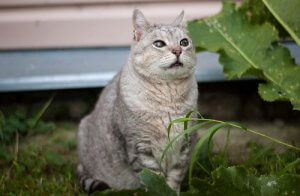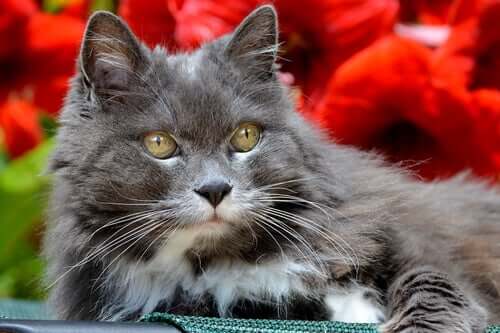Senior Cat Diseases: What You Need to Know

Similarly to people, our pet’s health begins to deteriorate as they grow older. Therefore, it’s crucial to be prepared and take good care of our best friend accordingly. That’s why in this article we’ll help you learn which are the most commonly found senior cat diseases. Keep reading!
The most frequent senior cat diseases
Aging cats are more prone to suffer certain ailments or diseases that rarely appear in kittens or young specimens. In addition to these ailments, we must add the changes in their behavior and a general lack of energy. Arm yourself with patience and offer them all your love so that they feel calmer – in case they suffer any of the following diseases when they’re older:
1. Arthritis
This is the most common disease – an inflammation in the joints that causes severe pain. A cat that suffers from this won’t able to perform certain activities such as jumping, climbing trees or even walking because of the stiffness in his legs or hips. As a result, it’s likely that the cat will be a little cranky and aggressive if he’s feeling sore.

If your pet suffers from arthritis, it’s very important that you take your pet to the vet to be checked out. They’ll need to be prescribed specific medication to reduce the pain. Arthritis is most commonly found in the elbows and hips. If the cat is overweight, it can get worse.
2. Dental problems
This is another one of the senior cat diseases that requires a visit to a specialist. Although periodontal changes begin at the age of two, they become more pronounced when the feline passes the age of 8 or 9. However, they don’t usually show pain until the problem is too noticeable.
Infections in the cat’s gums and mouth can lead to other complications such as a tooth root abscess, nasal infection, jaw fracture, etc. A good way to realize that your cat has a dental issue is by their breath, for instance. Summing up, a cat’s oral cleaning is very important at any stage of its life in order to prevent this type of ailment.
3. Obesity
A sedentary lifestyle in adult cats often results in them becoming overweight. Especially those who have been sterilized. They are more likely to suffer from obesity (whether it’s a female or a male) because they tend to eat more and are less active.
Thus, a good tip is to offer your cat food that is appropriate for their age and the amount of activity they do daily. Consult your vet and find out about low-calorie and low-fat options.
4. Hearing loss
Another of the most common diseases found in older cats. Gradually they start hearing less than before, and that’s noticeable in their behavior. For example, you won’t be able to wake them up so easily, they’ll ignore certain sounds that made them move before (opening a can of food, for instance) or they may not even look at you when you call them. You’ll need to take them to the vet to rule out any infections or serious illnesses that may be interfering with their hearing.
You’ll probably have to teach your cat how to identify gestures and from now on, toys don’t need to have bells or make sounds. They can instead produce lights or beams, and in that way they can interact with them.
5. Urinary and digestive problems
It’s very common for aging cats to defecate and urinate anywhere except the sandbox as they once did. This change in behavior can be due to several factors, such as suffering from a urinary or digestive infection or disease. Adult cats are more likely to suffer some of these pathologies:

- Colitis
- Inflammatory bowel disease
- Kidney or liver failure
- Anal sac disease
6. Blindness
Blindness is very common among senior cats. Over time, their senses diminish or deteriorate. As a result, they can develop cataracts, which appear as a kind of bluish-grey film or layer on the eye. Let’s not forget how important sight is for cats, because it allows them to walk in the dark.
However, they have other well-developed senses such as their smell and hearing. If your cat has gone blind, keep the corridors of the house clear, lift any objects off the floor, and don’t move the furniture. In this way, they’ll be able to orientate themselves without any issues.
We hope this article will help you care for your senior cat, as this is a very sensitive phase in their lives. See you next time!
Similarly to people, our pet’s health begins to deteriorate as they grow older. Therefore, it’s crucial to be prepared and take good care of our best friend accordingly. That’s why in this article we’ll help you learn which are the most commonly found senior cat diseases. Keep reading!
The most frequent senior cat diseases
Aging cats are more prone to suffer certain ailments or diseases that rarely appear in kittens or young specimens. In addition to these ailments, we must add the changes in their behavior and a general lack of energy. Arm yourself with patience and offer them all your love so that they feel calmer – in case they suffer any of the following diseases when they’re older:
1. Arthritis
This is the most common disease – an inflammation in the joints that causes severe pain. A cat that suffers from this won’t able to perform certain activities such as jumping, climbing trees or even walking because of the stiffness in his legs or hips. As a result, it’s likely that the cat will be a little cranky and aggressive if he’s feeling sore.

If your pet suffers from arthritis, it’s very important that you take your pet to the vet to be checked out. They’ll need to be prescribed specific medication to reduce the pain. Arthritis is most commonly found in the elbows and hips. If the cat is overweight, it can get worse.
2. Dental problems
This is another one of the senior cat diseases that requires a visit to a specialist. Although periodontal changes begin at the age of two, they become more pronounced when the feline passes the age of 8 or 9. However, they don’t usually show pain until the problem is too noticeable.
Infections in the cat’s gums and mouth can lead to other complications such as a tooth root abscess, nasal infection, jaw fracture, etc. A good way to realize that your cat has a dental issue is by their breath, for instance. Summing up, a cat’s oral cleaning is very important at any stage of its life in order to prevent this type of ailment.
3. Obesity
A sedentary lifestyle in adult cats often results in them becoming overweight. Especially those who have been sterilized. They are more likely to suffer from obesity (whether it’s a female or a male) because they tend to eat more and are less active.
Thus, a good tip is to offer your cat food that is appropriate for their age and the amount of activity they do daily. Consult your vet and find out about low-calorie and low-fat options.
4. Hearing loss
Another of the most common diseases found in older cats. Gradually they start hearing less than before, and that’s noticeable in their behavior. For example, you won’t be able to wake them up so easily, they’ll ignore certain sounds that made them move before (opening a can of food, for instance) or they may not even look at you when you call them. You’ll need to take them to the vet to rule out any infections or serious illnesses that may be interfering with their hearing.
You’ll probably have to teach your cat how to identify gestures and from now on, toys don’t need to have bells or make sounds. They can instead produce lights or beams, and in that way they can interact with them.
5. Urinary and digestive problems
It’s very common for aging cats to defecate and urinate anywhere except the sandbox as they once did. This change in behavior can be due to several factors, such as suffering from a urinary or digestive infection or disease. Adult cats are more likely to suffer some of these pathologies:

- Colitis
- Inflammatory bowel disease
- Kidney or liver failure
- Anal sac disease
6. Blindness
Blindness is very common among senior cats. Over time, their senses diminish or deteriorate. As a result, they can develop cataracts, which appear as a kind of bluish-grey film or layer on the eye. Let’s not forget how important sight is for cats, because it allows them to walk in the dark.
However, they have other well-developed senses such as their smell and hearing. If your cat has gone blind, keep the corridors of the house clear, lift any objects off the floor, and don’t move the furniture. In this way, they’ll be able to orientate themselves without any issues.
We hope this article will help you care for your senior cat, as this is a very sensitive phase in their lives. See you next time!
This text is provided for informational purposes only and does not replace consultation with a professional. If in doubt, consult your specialist.








